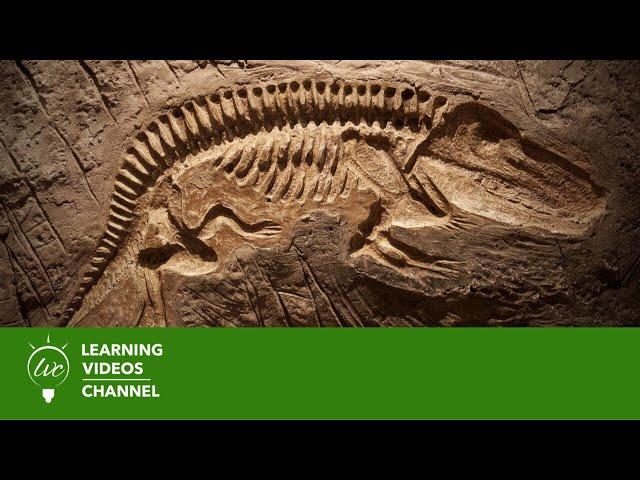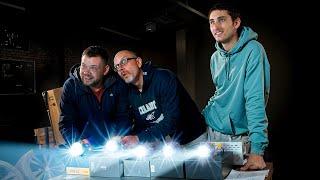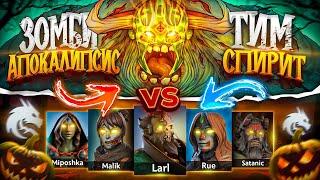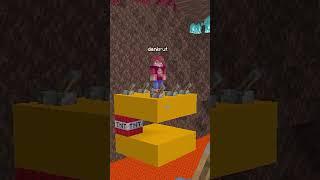
Fossils & Dinosaurs - Real World Science on the Learning Videos Channel
The age of dinosaurs comes alive as viewers take a trip back in time. Animatronic dinosaurs help to create what life was like 60 million years ago. In this program students will learn the names and distinctive features of many of the most common dinosaurs. They will discover how fossils are formed and come to understand that fossils can give us clues about how dinosaurs lived and died.
Take a trip back in time to the age of dinosaurs! State-of-the-art animatronic dinosaurs help to create what life was like 60 million years ago. Learn the names and distinctive features of many of the most common dinosaurs. Discover how fossils are formed and learn how they give us clues about how dinosaurs lived and died."
A fossil (from Classical Latin fossilis; literally, "obtained by digging")[1] is any preserved remains, impression, or trace of any once-living thing from a past geological age. Examples include bones, shells, exoskeletons, stone imprints of animals or microbes, objects preserved in amber, hair, petrified wood, oil, coal, and DNA remnants. The totality of fossils is known as the fossil record.
Paleontology is the study of fossils: their age, method of formation, and evolutionary significance. Specimens are usually considered to be fossils if they are over 10,000 years old.[2] The oldest fossils are around 3.48 billion years old[3][4][5] to 4.1 billion years old.[6][7] The observation in the 19th century that certain fossils were associated with certain rock strata led to the recognition of a geological timescale and the relative ages of different fossils. The development of radiometric dating techniques in the early 20th century allowed scientists to quantitatively measure the absolute ages of rocks and the fossils they host.
There are many processes that lead to fossilization, including permineralization, casts and molds, authigenic mineralization, replacement and recrystallization, adpression, carbonization, and bioimmuration.
Fossil of a Seymouria (extinct)
Fossils vary in size from one-micrometre (1 µm) bacteria to dinosaurs and trees, many meters long and weighing many tons. A fossil normally preserves only a portion of the deceased organism, usually that portion that was partially mineralized during life, such as the bones and teeth of vertebrates, or the chitinous or calcareous exoskeletons of invertebrates. Fossils may also consist of the marks left behind by the organism while it was alive, such as animal tracks or feces (coprolites). These types of fossil are called trace fossils or ichnofossils, as opposed to body fossils. Some fossils are biochemical and are called chemofossils or biosignatures.
Dinosaurs are a diverse group of reptiles[note 1] of the clade Dinosauria. They first appeared during the Triassic period, between 243 and 233.23 million years ago, although the exact origin and timing of the evolution of dinosaurs is the subject of active research. They became the dominant terrestrial vertebrates after the Triassic–Jurassic extinction event 201 million years ago; their dominance continued through the Jurassic and Cretaceous periods. The fossil record demonstrates that birds are modern feathered dinosaurs, having evolved from earlier theropods during the late Jurassic Period. As such, birds were the only dinosaur lineage to survive the Cretaceous–Paleogene extinction event 66 million years ago. Dinosaurs can therefore be divided into avian dinosaurs, or birds; and non-avian dinosaurs, which are all dinosaurs other than birds. This article deals primarily with non-avian dinosaurs.
Dinosaurs are a varied group of animals from taxonomic, morphological and ecological standpoints. Birds, at over 10,000 living species, are the most diverse group of vertebrates besides perciform fish. Using fossil evidence, paleontologists have identified over 500 distinct genera and more than 1,000 different species of non-avian dinosaurs. Dinosaurs are represented on every continent by both extant species (birds) and fossil remains. Through the first half of the 20th century, before birds were recognized to be dinosaurs, most of the scientific community believed dinosaurs to have been sluggish and cold-blooded. Most research conducted since the 1970s, however, has indicated that all dinosaurs were active animals with elevated metabolisms and numerous adaptations for social interaction. Some were herbivorous, others carnivorous. Evidence suggests that all dinosaurs were egg-laying; and nest-building was a trait shared by many dinosaurs, both avian and non-avian.
While dinosaurs were ancestrally bipedal, many extinct groups included quadrupedal species, and some were able to shift between these stances. Elaborate display structures such as horns or crests are common to all dinosaur groups, and some extinct groups developed skeletal modifications such as bony armor and spines.
Take a trip back in time to the age of dinosaurs! State-of-the-art animatronic dinosaurs help to create what life was like 60 million years ago. Learn the names and distinctive features of many of the most common dinosaurs. Discover how fossils are formed and learn how they give us clues about how dinosaurs lived and died."
A fossil (from Classical Latin fossilis; literally, "obtained by digging")[1] is any preserved remains, impression, or trace of any once-living thing from a past geological age. Examples include bones, shells, exoskeletons, stone imprints of animals or microbes, objects preserved in amber, hair, petrified wood, oil, coal, and DNA remnants. The totality of fossils is known as the fossil record.
Paleontology is the study of fossils: their age, method of formation, and evolutionary significance. Specimens are usually considered to be fossils if they are over 10,000 years old.[2] The oldest fossils are around 3.48 billion years old[3][4][5] to 4.1 billion years old.[6][7] The observation in the 19th century that certain fossils were associated with certain rock strata led to the recognition of a geological timescale and the relative ages of different fossils. The development of radiometric dating techniques in the early 20th century allowed scientists to quantitatively measure the absolute ages of rocks and the fossils they host.
There are many processes that lead to fossilization, including permineralization, casts and molds, authigenic mineralization, replacement and recrystallization, adpression, carbonization, and bioimmuration.
Fossil of a Seymouria (extinct)
Fossils vary in size from one-micrometre (1 µm) bacteria to dinosaurs and trees, many meters long and weighing many tons. A fossil normally preserves only a portion of the deceased organism, usually that portion that was partially mineralized during life, such as the bones and teeth of vertebrates, or the chitinous or calcareous exoskeletons of invertebrates. Fossils may also consist of the marks left behind by the organism while it was alive, such as animal tracks or feces (coprolites). These types of fossil are called trace fossils or ichnofossils, as opposed to body fossils. Some fossils are biochemical and are called chemofossils or biosignatures.
Dinosaurs are a diverse group of reptiles[note 1] of the clade Dinosauria. They first appeared during the Triassic period, between 243 and 233.23 million years ago, although the exact origin and timing of the evolution of dinosaurs is the subject of active research. They became the dominant terrestrial vertebrates after the Triassic–Jurassic extinction event 201 million years ago; their dominance continued through the Jurassic and Cretaceous periods. The fossil record demonstrates that birds are modern feathered dinosaurs, having evolved from earlier theropods during the late Jurassic Period. As such, birds were the only dinosaur lineage to survive the Cretaceous–Paleogene extinction event 66 million years ago. Dinosaurs can therefore be divided into avian dinosaurs, or birds; and non-avian dinosaurs, which are all dinosaurs other than birds. This article deals primarily with non-avian dinosaurs.
Dinosaurs are a varied group of animals from taxonomic, morphological and ecological standpoints. Birds, at over 10,000 living species, are the most diverse group of vertebrates besides perciform fish. Using fossil evidence, paleontologists have identified over 500 distinct genera and more than 1,000 different species of non-avian dinosaurs. Dinosaurs are represented on every continent by both extant species (birds) and fossil remains. Through the first half of the 20th century, before birds were recognized to be dinosaurs, most of the scientific community believed dinosaurs to have been sluggish and cold-blooded. Most research conducted since the 1970s, however, has indicated that all dinosaurs were active animals with elevated metabolisms and numerous adaptations for social interaction. Some were herbivorous, others carnivorous. Evidence suggests that all dinosaurs were egg-laying; and nest-building was a trait shared by many dinosaurs, both avian and non-avian.
While dinosaurs were ancestrally bipedal, many extinct groups included quadrupedal species, and some were able to shift between these stances. Elaborate display structures such as horns or crests are common to all dinosaur groups, and some extinct groups developed skeletal modifications such as bony armor and spines.
Тэги:
#Fossil #dinosaur #teeth #bones #remains #body_fossils #trace_fossil #impression #footprint #paleontologist #triceratops #carnivore #herbivore #Paleozoic #Mesozoic #Cenozoic #Triassic_period #Jurassic_period #Cretaceous #Saurischians #Theropoda #Ornithischia #extinctКомментарии:
Fossils & Dinosaurs - Real World Science on the Learning Videos Channel
Harmony Square - Educational Videos & Activities
Hà Nội: Băn khoăn dự án “nắn” quy hoạch quốc lộ 6 | Truyền hình Quốc hội Việt Nam
Truyền Hình Quốc Hội Việt Nam
[TRỰC TIẾP] Quốc hội bầu Chủ tịch Nước vào hôm nay 21/10
Truyền hình Đài Tiếng nói Việt Nam - VOVTV
德國Vlog|去換車子夏胎|回母校|父親節之失敗的野餐
Sandy Fibu
Thủ tướng Chính phủ trả lời chất vấn | Truyền hình Quốc hội Việt Nam
Truyền Hình Quốc Hội Việt Nam
Yet Not I But Through Christ In Me - Boyce Worship Collective
Southern Seminary



![[TRỰC TIẾP] Quốc hội bầu Chủ tịch Nước vào hôm nay 21/10 [TRỰC TIẾP] Quốc hội bầu Chủ tịch Nước vào hôm nay 21/10](https://ruvideo.cc/img/upload/b0FFbTlzb1dwRUY.jpg)






















